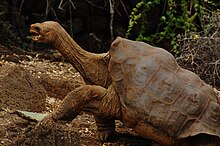Endling
The 4 April 1996 issue of Nature published a correspondence in which commentators suggested that a new word, endling, be adopted to denote the last individual of a species.
[1][3] The word endling appeared on the walls of the National Museum of Australia in Tangled Destinies, a 2001 exhibition by Matt Kirchman and Scott Guerin, about the relationship between Australian peoples and their land.
In the exhibition, the definition, as it appeared in Nature, was printed in large letters on the wall above two specimens of the extinct Tasmanian tiger: "Endling (n.) The last surviving individual of a species of animal or plant".
"[4][5] In The Flight of the Emu: A Hundred Years of Australian Ornithology 1901-2001, author Libby Robin stated that "the very last individual of a species" is "what scientists refer to as an 'endling'".
[8] Author Eric Freedman describes endling as "a word with finality", stating, "It is deep-to-the-bone chilling to know the exact date a species disappeared from Earth.






